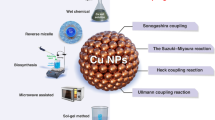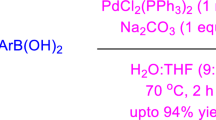Abstract
Iron-catalyzed direct reduction of allylic halides with benzylic alcohol was achieved, providing a new, simple, and efficient method for conducting highly regioselective hydrodehalogenation. This method not only features a readily available reductant, an inexpensive catalyst, simple manipulation, and good tolerance of functional groups including nitriles, nitro, esters, and methoxyl groups, it also has mild reaction conditions and shows complete regioselectivity in that only halides sited at the allylic position are reduced. Alternatively, this method can be applied in the selective transformation of benzylic alcohols to aromatic aldehydes without overoxidation to carboxylic acids.
Similar content being viewed by others
References
Pinder AR. The hydrogenolysis of organic halides. Synthesis-stuttgart, 1980, (6):425–452
Hudlicky M. Comprehensive Organic Synthesis. In Trost BM, Fleming I. Eds. Pergamon: Oxford, 1991, 8:895
Parry RJ, Li Y, Gomez EE. Biosynthesis of the antitumor antibiotic sparsomycin. J Am Chem Soc, 1992, 114(15):5946–5959
Dorman G, Otszenski JD, Prestwich GD. Synthesis of highly tritiated 4-benzoyl-L-phenylalanine, a photoactivatable amino acid. J Org Chem, 1995, 60(7):2292–2297
Trestiege I, Maleczka Jr RE. A new approach for the generation and reaction of organotin hydrides: The development of reactions catalytic in tin. J Org Chem, 1999, 64(2):342–343
Davies CJE, Page MJ, Ellul CE, Mahon MF, Whittlesey MK. Ni(I) and Ni(II) ring-expanded N-heterocyclic carbene complexes: C-H activation, indole elimination and catalytic hydrodehalogenation. Chem Commun, 2010, (46):5151–5153
Hitchman ML, Spackman RA, Ross NC, Agra C. Disposal methods for chlorinated aromatic waste. Chem Soc Rev, 1995, (24):423–430
Hites RA. Environmental behavior of chlorinated dioxins and furans. Acc Chem Res, 1990, 23(6):194–201
Arai H, Ashizawa T, Gomi K, Kono M, Saito H, Kasai M. Synthesis and antitumor-activity of various 6-demethylmitomycins and 6-demethyl-6-halomitomycins. J Med Chem, 1995, 38(16):3025–3033
Anizon F, Moreau P, Sancelme M, Voldoire A, Prudhomme M, Ollier M, Severe D, Riou JF, Bailly C, Fabbro D, Meyer T, Aubertin AM. Syntheses, biochemical and biological evaluation of staurosporine analogues from the microbial metabolite rebeccamycin. Bioorg Med Chem, 1998, 6(9):1597–1603
Marminon C, Facompre M, Bailly C, Hickman J, Pierre A, Pfeiffer B, Renard P, Prudhomme P. Dimers from dechlorinated rebeccamycin: Synthesis, interaction with DNA, and antiproliferative activities. Eur J Med Chem, 2002, 37(5):435–440
Liégault B, Petrov I, Gorelsky SI, Fagnou K. Modulating reactivity and diverting selectivity in palladium-catalyzed heteroaromatic direct arylation through the use of a chloride activating/blocking group. J Org Chem, 2010, 75(4):1047–1060
Masuda N, Tanba S, Mori A. Stepwise construction of head-to-tail-type oligothiophenes via iterative palladium-catalyzed CH arylation and halogen exchange. Org Lett, 2009, 11(11):2297–2300
Zhao D, Wang W, Yang F, Lan J, Yang L, Gao G, You J. Copper-catalyzed direct C arylation of heterocycles with aryl bromides: Discovery of fluorescent core frameworks. Angew Chem Int Ed, 2009, 48(27):3296–3300
Frimmel J, Zdrazil M. Hydrogenlysis of organochloorinated pollutantsparallel hydrodesulfurization of methylrthiophene and hydrodechlorination of dichlorobenzene over carbon-supported nickel, molybdenum and nickel-molybdenum sulfide catalysis. J Chem Technol Biotechnol, 1995, 63(1):17–24
He J, Ritalahti KM, Yang KL, Koenigsberg SS, Löffler FE. Detoxification of vinyl chloride to ethene coupled to growth of an anaerobic bacterium. Nature, 2003, 424(6944):62–65
Logan ME, Oinen ME. Dechlorination of aryl chlorides with sodium formate using a homogeneous palladium catalyst. Organometallics, 2006, 25(4):1052–1054
Urbano FJ, Marinas JM, Hydrogenolysis of organohalogen compounds over palladium supported catalysts. J Mol Catal A, 2001, 173(1–2):329–345
Selva M, Tundo P, Perosa A. Hydrodehalogenation of halogenated aryl ketones under multiphase conditions. 5. Chemoselectivity toward aryl alcohols over a Pt/C catalyst. J Org Chem, 1998, 63(10):3266–3271
Viciu MS, Grasa GA, Nolan SP. Catalytic dehalogenation of aryl halides mediated by a palladium/imidazolium salt system. Organometallics, 2001, 20(16):3607–3612
Zawisza AM, Muzart J. Pdcatalyzed reduction of aryl halides using dimethylformamide as the hydride source. Tetrahedron Lett, 2007, 48(38):6738–6742
Moon J, Lee S. Palladium catalyzed-dehalogenation of aryl chlorides and bromides using phosphite ligands. J Organomet Chem, 2009, 694(3):473–477
Alonso F, Beletskaya IP, Yus M. Metal-mediated reductive hydrodehalogenation of organic halides. Chem Rev, 2002, 102(11):4009–4092
Hara T, Kaneta T, Mori K, Mitsudome T, Mizugaki T, Ebitanic K, Kaneda, K. Magnetically recoverable heterogeneous catalyst: Palladium nanocluster supported on hydroxyapatite-encapsulated gamma-Fe2O3 nanocrystallites for highly efficient dehalogenation with molecular hydrogen. Green Chem, 2007, 9(11):1246–1251
Esteruelas, MA, Herrero J, Olivàn M. Dehalogenation of hexachlorocyclohexanes and simultaneous chlorination of triethylsilane catalyzed by rhodium and ruthenium complexes. Organometallics, 2004, 23(16):3891–3897
Peterson AA, McNeill K. Catalytic dehalogenation of sp2 C-F and C-Cl bonds in fluoro- and chloroalkenes. Organometallics, 2006, 25(21):4938–4930
Wang JL, Zhu ZY, Huang W, Deng ML, Zhou XG. Air-initiated hydrosilylation of unactivated alkynes and alkenes and dehalogenation of halohydrocarbons by tris(trimethylsilyl)silane under solvent-free conditions. J Organomet Chem, 2008, 693(12):2188–2192
Fakhfakh MA, Franck X, Hocquemiller R, Figadère B. Iron catalyzed hydrodebromination of 2-aryl-1,1-dibromo-1-alkenes. J Organomet Chem, 2001, 624(1–2):131–135
Czaplik WM, Grupe S, Mayer M, von Wangelin AJ. Practical iron-catalyzed dehalogenation of aryl halides. Chem. Commun, 2010, (46):6350–6352
Moglie Y, Alonso F, Vitale C, Yusb M, Radivoy G. Active-iron-promoted hydrodehalogenation of organic halides. Appl Cat A: Gen 2006, 313(1):94–100
Baxter RM. Reductive dechlorination of certain chlorinated organic-compounds by reduced hematin compared with their behavior in the environment. Chemosphere, 1990, 21(4–5):451–458
Krone UE, Thauer RK, Hogenkamp HPC, Steinbach K. Reductive formation of carbon-monoxide from CCl4 and freon-11, freon-12, and freon-13 catalyzed by corrinoids. Biochemistry, 1991, 30(10):2713–2719
Maldotti A, Amadelli R, Bartocci C, Carassiti V, Polo E, Varani G. Photochemistry of iron-porphyrin complexes. Biomimetics and catalysis. Coord Chem Rev, 1993, 125(1–2):143–154
Gantzer CJ, Wackett LP. Reductive dechlorination catalyzed by bacterial transition-metal coenzymes. Environ Sci Technol, 1991, 25(4):715–722
Fu NY, Zhao XM, Yuan YF, Wang JT. Reductive deoxygenation of carbonyl to methylene by LiAlH4/InBr3. Chinese Chem Lett, 2003, 14(10):1018–1020
Enholm EJ, Schulte II JP. Convenient catalytic free radical reductions of alkyl halides using an organotin reagent on non-cross-linked polystyrene support. Org Lett, 1999, 1(8):1275–1277
Cellier PP, Spindler JF, Taillefer M, Cristau HJ. Pd/C-catalyzed room-temperature hydrodehalogenation of aryl halides with hydrazine hydrochloride. Tetrahedron Lett, 2003, 44(38):7191–7195
Pham PD, Legoupy S. Organotin reagents supported on ionic liquid: Highly efficient catalytic free radical reduction of alkyl halides. Tetrahedron Lett, 2009, 50(27):3780–3782
Hales NJ, Heaney H, Hollinshead JH, Lai SMF, Singh P. The dechlorination of some highly chlorinated naphthalene derivatives. Tetrahedron, 1995, 51(28):7777–7790
Chelucci G, Baldino S, Pinna GA, Pinna G. Synthetic methods for the hydrodehalogenation of halogenated heterocycles. Curr Org Chem, 2012, 16(24):2921–2945
Wiener H, Blum J, Sasson Y. Transfer hydrogenolysis of aryl halides and other hydrogen acceptors by formate salts in the presence of palladium/ carbon catalyst. J Org Chem, 1991, 56(21):6145–6148
Aslam NA, Rajkumar V, Reddy C, Yasuda M, Baba A, Babu SA. Indium-mediated addition of gamma-substituted allylic halides to N-Aryl alpha-imino esters: Diastereoselective production of beta, beta′-dsubstituted alpha-amino acid derivatives with two contiguous stereocenters. Eur J Org Chem, (23):4395–4411
Frye EC, O’Connor CJ, Twigg DG, Elbert B, Laraia L, Hulcoop DG, Venkitaraman AR, Spring DR. Palladium-catalysed cross-coupling of vinyldisiloxanes with benzylic and allylic halides and sulfonates. Chem Eur J, 2012, 18(28):8774–8779
Huang W, Wang JL, Shen QS, Zhou XG. An efficient Yb(OTf)3 catalyzed alkylation of 1,3-dicarbonyl compounds using alcohols as substrates. Tetrahedron Lett, 2007, 48(23):3969–3973
Huang W, Wang JL, Shen QS, Zhou XG. Yb(OTf)3-catalyzed propargylation and allenylation of 1,3-dicarbonyl derivatives with propargylic alcohols: One-pot synthesis of multi-substituted furocoumarin. Tetrahedron, 2007, 63(47):11636–11643
Huang W, Shen QS, Wang JL, Zhou XG. One-step synthesis of substituted dihydro- and tetrahydroisoquinolines by FeCl3·6H2O catalyzed intramolecular Friedelrafts reaction of benzylamino-substituted propargylic alcohols. J Org Chem, 2008, 73(4):1586–1589
Huang W, Zheng PZ, Zhang ZX, Liu RT, Chen ZX, Zhou XG. Controllable one-step synthesis of spirocycles, polycycles, and di- and tetrahydronaphthalenes from arylubstituted propargylic alcohols. J Org Chem, 2008, 73(17):6845–848
Wang JL, Huang W, Zhang ZX, Xiang X, Liu RT, Zhou XG. FeCl3·6H2O catalyzed disproportionation of allylic alcohols and selective allylic reduction of allylic alcohols and their derivatives with benzyl alcohol. J Org Chem, 2009, 74(9):3299–3304
Fried J, Florey K, Sabo EF, Herz JE, Restivo AR, Borman A, Singer FM. The reaction of thionyl chloride with allylic alcohols. J Am Chem Soc, 1955, 77(15):4182–4183
Young WG, Caserio Jr FF, Brandon Jr DD. Allylic rearrangements. XLIX. The controlled conversion of α- and γ-methylallyl alcohols to chlorides with thionyl chloride. J Am Chem Soc, 1960, 82(23):6163–6168
Yadav VK, Babu KG. Acetyl chloride-ethanol brings about a remarkably efficient conversion of allyl acetates into allyl chlorides. Tetrahedron, 2003, 59(46):9111–9116
Obafemi CA, Lee CC. Lithium aluminium hydride reduction of some triarylvinyl bromides and acetates catalyzed by some transition metal chlorides. Can J Chem, 1990, 68(11):1998–2000
Amer W, Abdelouahdi K, Ramananarivo HR, Zahouily M, Essassi E, Fihri A, Solhy A. Oxidation of benzylic alcohols into aldehydes under solvent-free microwave irradiation using new catalyst-support system. Curr Org Chem, 2013, 17(1):72–78
Gazi S, Ananthakrishnan R, Bromodimethylsulfonium bromide as a potential candidate for photocatalytic selective oxidation of benzylic alcohols using oxygen and visible light. RSC Adv, 2012, 2(20):7781–7787
Lim M, Oh S, Rhee H. Pd/C catalyzed oxidation of secondary benzylic alcohols using chlorobenzene under an inert condition. Bull Korean Chem Soc, 2011, 32(8):3179–3182
Author information
Authors and Affiliations
Corresponding author
Rights and permissions
About this article
Cite this article
Zhang, H., Liu, R. & Zhou, X. FeCl3·6H2O-catalyzed selective reduction of allylic halides to alkenes with concomitant oxidation of benzylic alcohols to aldehydes. Sci. China Chem. 57, 282–288 (2014). https://doi.org/10.1007/s11426-013-5042-2
Received:
Accepted:
Published:
Issue Date:
DOI: https://doi.org/10.1007/s11426-013-5042-2




